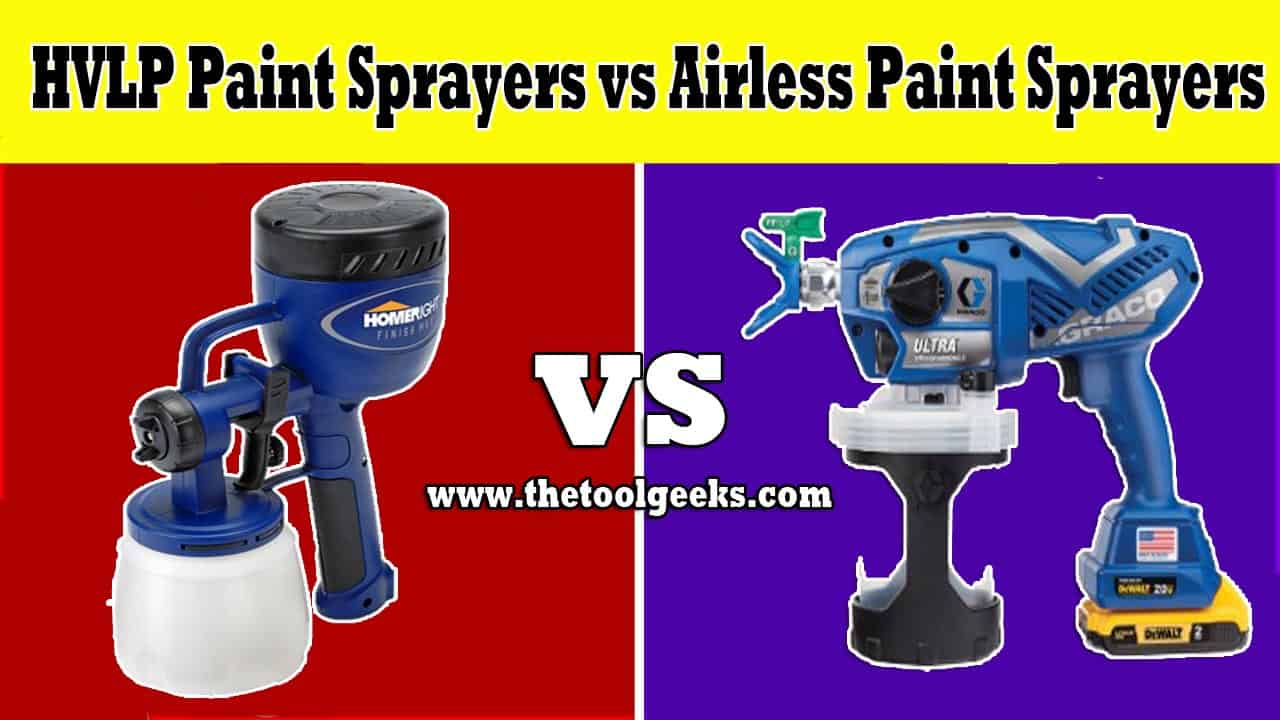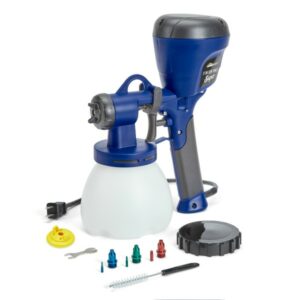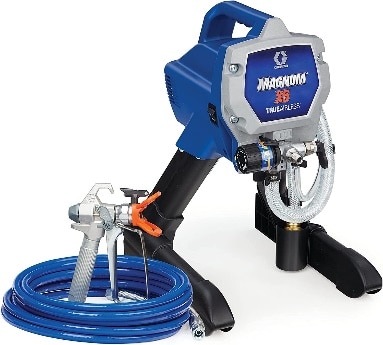HVLP vs Airless Paint Sprayer: What’s the difference?
TheToolGeeks.com is a participant in the Amazon Services LLC Associates Program and other affiliate advertising programs. We may earn from qualifying purchases. (Learn More).
If I had one dollar for every time someone asked me about HVLP vs airless paint sprayers, I would be a millionaire. Okay, maybe not a millionaire, but I would have some extra pocket money.
And to be fair, this is a very important question that everyone looking to buy a paint sprayer should know. What is better – HVLP vs Airless Paint Sprayer?
A few years ago, everyone was using paint rollers, and a few people were familiar with paint sprayers and how they work. But since paint sprayers are better and do a better job, they became popular quickly, and many people started using them. Nowadays, almost everyone who is doing home renovations uses a paint sprayer.
Since a lot of people started using them, a lot of companies caught up and created their own products. There are a lot of different models available and a lot of different paint sprayer types, but the most used ones are the HVLP and the Airless Paint Sprayers.
Airless Paint Sprayers vs HVLP Paint Sprayers – The Differences
Before listing all their differences, both sprayers are good but used for different projects.
- Atomization – HVLP sprayers use air to archive atomization, and Airless sprayers use paint to do it.
- Paint Thickness– Because of the atomization, airless paint sprayers can spray thick paint, and HVLP paint sprayers are not (unless you thin it first).
- Speed– Airless Paint sprayers are faster. They can spray up to 7 liters per minute and use up to 3000 PSI, whereas HVLP sprayers use 20 PSI.
- Price – HVLP sprayers are cheaper; they usually cost 2x less.
- Precision – Due to the higher pressure, airless paint sprayers are hard to control; therefore, they are not very precise. HVLP sprayers are precise.
- Overspray – Airless sprayers spray at a much higher pressure and produce more overspray than an HVLP sprayer. Overspray can damage floors and furniture if masking isn’t done in advance.
- Finish –An HVLP sprayer atomizes paint at lower pressures, leaving a finer finish. This also means you have more control over the paint flow and thickness.
- Thinning – You don’t have to thin the material used in an airless sprayer before you begin. However, you do have to thin the paint when using an HVLP.
- Cleanup – A cup sprayer results in more cleanup and maintenance because you have to ensure the fluid nozzle stays unobstructed. If not, when it sprays, the pattern will be uneven. Other sprayers must be flushed with clean water and the filters rinsed.
There are a lot of money differences that you can read down below. But, to sum it up, the difference is that HVLP sprayers are used when you need a detailed and high-quality finish, and Airless sprayers are used when you need speed and to spray large surfaces without needing a high-quality finish.
What Are HVLP Paint Sprayers?
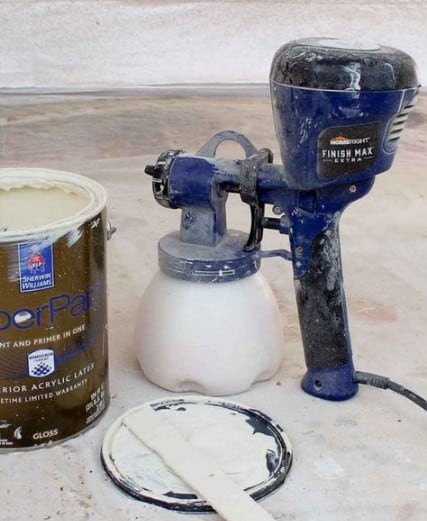
Before explaining how these sprayers work, let’s explain the name – The HVLP stands for High Volume Less Pressure. This means that it will use less pressure but spray more paint.
Unlike other traditional sprayers, HVLP paint sprayers come with two separate chambers – one for the fluid and the other for the air.
The fluid is fed at the fluid nozzle, and the air goes at the fluid only after the fluid leaves the nozzle.
This allows the tool to create atomization, which helps with the finish quality. Usually, the HVLP sprayers provide a very smooth finish quality resulting from the atomization.
Learn More— LVLP vs. HVLP
And because of the HVLP technology, the sprayer will use less pressure but will spray a lot more material.
But, even though it doesn’t need a lot of pressure, you still need an air compressor so you can spray. Although, some of the models don’t need an air compressor.
If interested, you can check our post about the best HVLP paint sprayer.
When Should You Use an HVLP Paint Sprayer?
Although HVLP paint sprayers are good for almost every painting project, there are some things that they are the best at. I usually use HVLP paint sprayers when I need a quality finish rather than a fast finish.
Another good scenario where you can use HVLP sprayers is when you don’t need a lot of paint. Usually, HVLP sprayers work with different painting cups.
You can use paint cups of different sizes, gravity-fed cups, suction cups, etc. And if you don’t need a lot of paint, you can attach a smaller paint cup and spray, knowing that you won’t spend more paint than necessary.
HVLP sprayers are known for detailed projects and are mostly used when you need a fine finish.
Where Shouldn’t You Use an HVLP Paint Sprayer?
You can still use HVLP sprayers for these tasks, but there are better options available (Airless Paint Sprayers), and if you have the chance, it’s better to choose them than an HVLP paint sprayer.
I don’t recommend using HVLP sprayers if you need to spray a very large surface. Since these sprayers use low pressure, they won’t be able to finish the whole surface fast. As mentioned, HVLP sprayers are mostly made for detailed projects, not large ones.
Another scenario where you shouldn’t use HVLP sprayers is dealing with thick paint. As mentioned earlier, the air comes only after the paint leaves the nozzle. If the paint is too thick, the machine struggles to atomize the paint. When dealing with thick paint, it’s better to thin it before.
Learn More— Best Spray Gun For Latex Paint
What Are Airless Paint Sprayers?
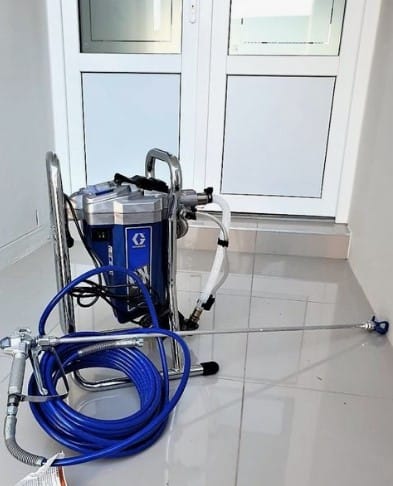
Many people – mostly professionals, use airless paint sprayers. These sprayers use atomization too- but they archive it in another way.
As mentioned earlier – HVLP sprayers use air after the paint has left the nozzle to create atomization. But airless paint sprayers don’t use air – hence the name “Airless.”
The airless paint sprayers archive atomization by forcing a huge amount of paint up the hose to the small nozzle at the spray gun. These sprayers don’t use air, but they use paint to create the atomization.
Learn here: Top Rated Airless Sprayers
Airless Paint Sprayers Pros
Because of their technology, airless paint sprayers are very good when spraying a large surface. They are powerful and fast, making them perfect for spraying large surfaces such as warehouses, home walls, etc.
Since they don’t need air to atomize the paint, you can easily use thick paints such as fire-resistant paint and even plaster. In most cases, you don’t need to thin the materials. And they are very fast. Some models can spray up to 7 liters of paint per minute, which is way faster than any HVLP sprayer.
In comparison to the HVLP sprayers, airless sprayers use more pressure. HVLP sprayers usually use 20 PSI, and airless paint sprayers can use up to 3000 PSI. That’s a huge difference.
Learn More— Kitchen Cabinet Spray Guns Review
Airless Paint Sprayers Cons
Because of the atomization technique, these sprayers are only made for professionals and experienced people. You can easily mess up and overspray, which can be a huge problem.
Airless paint sprayers also cost a lot more money. Sometimes, you need to pay 2x more money to get an airless paint sprayer than you would for an HVLP paint sprayer.
Because of the high pressure, it is very hard to control the paint using an airless sprayer; therefore, airless paint sprayers are less accurate. Also, it doesn’t offer a finish as good as the HVLP sprayers.
Learn More— How to get rid of paint smells?
HVLP vs Airless Paint Sprayer for Cabinets
When painting cabinets, either of these paint spray options would be suitable. However, an HVLP will produce a finer finish and uses paint that has been thinned out.
An HVLP is also more efficient regarding vertical spraying of the cabinets compared to an airless one. With this, you are less likely to encounter paint runs because you spray at lower pressure.
Can an Airless Sprayer Be Used to Paint a Vehicle?
You want to use an automotive HVLP spray gun when painting a vehicle. This gun offers a much softer spray while maintaining a high air volume at a low pressure.
This kind of sprayer is good for smaller areas like the body panel, bumper, and fender of your vehicle. It can also be used effectively to achieve smaller details when painting.
Can You Use an HVLP Gun to Spray Latex Paint?
Yes. You can use an HVLP gun to spray latex paint. You want to thin the paint with water and mix well before spraying. The amount of water you need to thin out the paint depends on the brand and quality of the paint you decide to use.
Start with adding ten percent water. If the paint is too thick after it has been mixed, add a small bit of water and mix it again. Continue to do this until you have the right consistency for your paint gun.
Can You Spray Stain With an Airless Sprayer?
Stain is often used to preserve and protect surfaces from sun and weather. When you use an airless sprayer for staining, you can even finish your project much faster than if you were just using rollers and brushes alone.
You are not limited to regular indoor and outdoor applications. The sprayer can be used to stain wooden surfaces like your fence, offering fast and more precise results.
What Is the Best Paint Sprayer?
Most professionals choose to use HVLP paint sprayers, also sometimes known as turbo sprayers, because they are good for trimming, finish work, staining, cabinet painting, and other detailed applications. An HVLP spray painter provides more accuracy and speed.
In this case, the best HVLP spray painter would be the HomeRight Super Finish Max sprayer. With this HVLP sprayer, everyone, from novices to DIYers to professionals, can sprayer paint cabinets, furniture, decks and other woodworking projects with ease. It has an air turbine, so you don’t need a separate air compressor to use it. And it uses low pressure to provide a high volume of paint without over spraying the object.
However, an airless spray painter evenly distributes a paint coating onto whatever surface you are working with and can be used in different woodwork applications, walls, ceilings, and even some metal objects. They are a good choice for homeowners looking to do home improvement projects.
In this case, the best airless spray painter would be the Graco Magnum X5 Airless Paint Sprayer. With this paint spray gun, you control the paint spray and flow with fully adjustable pressure.
You can also spray unthinned paint at high pressure with the Graco Magnum, and the flexible suction tube allows you to spray directly from a one or five-gallon paint bucket. It is the ideal paint sprayer for both indoor and outdoor projects.
Key Features
- Allows for ultimate control
- Sprays directly from bucket
- Adjustable pressure control
- Hardened stainless steel piston pump
- Premium spray gun with filter
- Less overspray with TrueAirless Spray Tip
- Connect to garden hose for easy and fast cleanup
Do Airless Sprayers Use More Paint?
Airless sprayers tend to use more paint because the paint is atomized into tiny droplets. A lot of the droplets do end up on the surface you are working on, but some tend to drift away. Overall, a sprayer will use up to 33 percent more paint than a paint roller.
So, if you need a more budget-friendly way to paint, then a roller may be the way to go. However, if you want a better finish, more control, and faster results, investing in an airless sprayer and more paint is definitely the way to go.
Final Words
These are all the pieces of information you need about HVLP vs airless paint sprayers. Which one should you choose? Well, it depends on your project. Find out what project you will work on, and you will know your answer. Don’t forget; we made a list of the best models of these sprayers, so make sure to check them out.
Amazon and the Amazon logo are trademarks of Amazon.com, Inc, or its affiliates.
